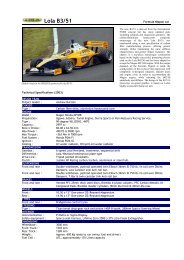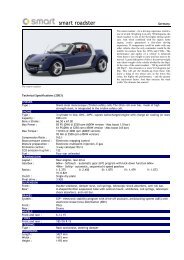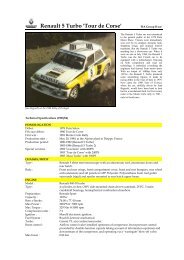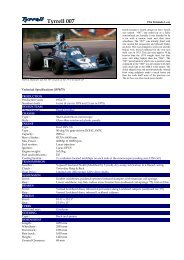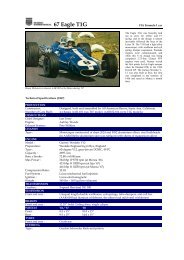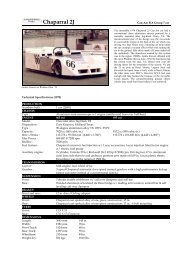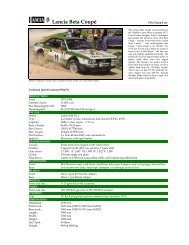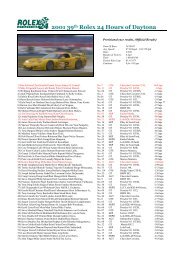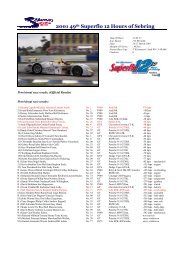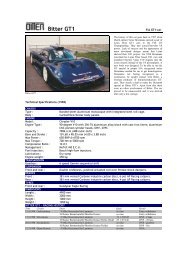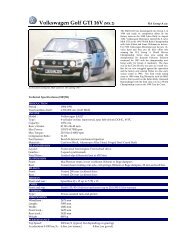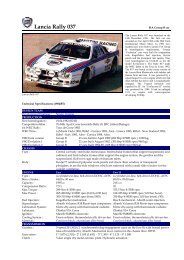Saab 9³ Viggen Pikes Peak - Motorsports Almanac
Saab 9³ Viggen Pikes Peak - Motorsports Almanac
Saab 9³ Viggen Pikes Peak - Motorsports Almanac
Create successful ePaper yourself
Turn your PDF publications into a flip-book with our unique Google optimized e-Paper software.
<strong>Saab</strong> <strong>9³</strong> <strong>Viggen</strong> <strong>Pikes</strong> <strong>Peak</strong> <strong>Pikes</strong> <strong>Peak</strong> Open/Unlimited class<br />
Per Eklund won his class, and came home second overall, on the 2000 <strong>Pikes</strong> <strong>Peak</strong> hill climb.<br />
Technical Specifications (2000)<br />
For <strong>Pikes</strong> <strong>Peak</strong>, <strong>Saab</strong>, Per Eklund, have<br />
teamed with Trollspeed of Trollhättan to<br />
create the most powerful <strong>Saab</strong> ever – an allwheel<br />
drive 9-3 <strong>Viggen</strong> with a <strong>Saab</strong><br />
Ecopower 2.0-liter engine that delivers 750<br />
horsepower at 8,000 rpm and 518 Ib.-ft. of<br />
torque at 6,500 rpm. With this amount of<br />
power, all-wheel drive and a 6-speed<br />
sequential shift transmission, the 9-3<br />
<strong>Viggen</strong>'s acceleration is in the Formula One<br />
class: 0-60 mph in 2.3 seconds. The car is<br />
geared for a top speed of 155 mph. The<br />
vehicle is constructed on a very strong<br />
tubular frame that gives both high torsional<br />
stiffness and good protection. The protection<br />
can be useful if anything goes wrong - the<br />
race up <strong>Pikes</strong> <strong>Peak</strong> is quite fast (the average<br />
speed of last year's winner was nearly 75<br />
mph) and the course is entirely lacking in<br />
safety railings. "If you happen to get one<br />
skid too many," notes Eklund, "you're not in<br />
the way to obstruct the guys coming up<br />
behind you.<br />
CHASSIS<br />
Type : Steel tube space frame, carbon fibre floor.<br />
Body : Carbon fibre panels<br />
ENGINE<br />
Type : 4-cylinder in-line, chain-driven DOHC, 4VPC, longitudinal.<br />
Preparation : Trollspeed, Sweden<br />
Capacity : 2046 cc<br />
Bore x Stroke : 92.00 x 77.00 mm<br />
Max Power : 750 PS @ 8000 rpm (at 3.0 bar or 42.8 psi)<br />
Max Torque : 702.3 Nm (518 ft lbs) @ 6500 rpm<br />
Compression Ratio : 9.0:1<br />
Turbo : Garrett T04S<br />
Fuel : 115-octane Elf.<br />
TRANSMISSION<br />
Layout : Front engine, longitudinally mounted, four-wheel drive.<br />
Gearbox : 6-speed Prodrive, H-pattern shift.<br />
Final drive : Programmable electro-hydraulically controlled Prodrive active differentials.<br />
SUSPENSION<br />
Front : MacPherson struts, fully adjustable shock absorbers with remote reservoirs,<br />
Rear : MacPherson strut with longitudinal and transverse link, fully adjustable shock absorbers<br />
with remote reservoirs.<br />
BRAKES<br />
Front and rear : Ventilated discs, 6-pot calipers, Ferodo pads<br />
Rear : Ventilated discs, 4-pot calipers, Ferodo pads<br />
WHEELS<br />
Front and rear : OZ<br />
TYRES<br />
Front and rear : Pirelli<br />
STEERING<br />
Type : Power assisted rack and pinion.<br />
DIMENSIONS<br />
Curb Weight : 948 kg / 2090 lbs<br />
PERFORMANCE<br />
Top Speed : 249.4 kph / 155.0 mph<br />
Acceleration 0-60 mph : 2.3 seconds
SAAB ENTERS PER EKLUND IN THE PIKES PEAK HILL CLIMB CLASSIC 07/2000<br />
On July 4, Swedish veteran champion race car driver Per Eklund will pilot a modified <strong>Saab</strong> 9-3 <strong>Viggen</strong> in the <strong>Pikes</strong> <strong>Peak</strong> Open class<br />
of the 78'h running of the <strong>Pikes</strong> <strong>Peak</strong> International Hill Climb – the second oldest automobile race in the U.S.A. With a 750-HP<br />
<strong>Saab</strong> Ecopower 2.0-liter engine, this <strong>Viggen</strong> is the most powerful <strong>Saab</strong> automobile ever.<br />
NORCROSS, Ga. - The route to the top of <strong>Pikes</strong> <strong>Peak</strong> is not a challenge for the faint-of- heart. It's a 1 2-mile course of<br />
both pavement and gravel that starts at an elevation of 9,402 feet and ends at 14,110 feet. Known as "The Race to<br />
the Clouds," this event is the second oldest automobile race in the U.S. (after the Indianapolis 500) and features 156<br />
turns with no guardrails. For the event, <strong>Saab</strong> and 1999 European Rallyaoss Champion, Per Eklund, have teamed with<br />
Trollspeed of Trollhättan to create the most powerful <strong>Saab</strong> ever – an all-wheel drive 9-3 <strong>Viggen</strong> with a <strong>Saab</strong> Ecopower<br />
2.0-liter engine that delivers 750 horsepower at 8,000 rpm and 518 Ib.-ft. of torque at 6,500 rpm. With this amount<br />
of power, all-wheel drive and a 6-speed sequential shift transmission, the 9-3 <strong>Viggen</strong>'s acceleration is in the Formula<br />
One class: 0-60 mph in 2.3 seconds. The car is geared for a top speed of 155 mph. The vehicle is constructed on a<br />
very strong tubular frame that gives both high torsional stiffness and good protection. The protection can be useful if<br />
anything goes wrong, the race up <strong>Pikes</strong> <strong>Peak</strong> is quite fast (the average speed of last year's winner was nearly 75 mph)<br />
and the course is entirely lacking in safety railings. "If you happen to get one skid too many," notes Eklund, "you're not<br />
in the way to obstruct the guys coming up behind you." Eklund labors under a handicap compared to the local and<br />
veteran drivers: he's only recently seen the hill for the first time. However, he was able to make a few practice runs<br />
in early June and is excited about his chances. "I'm really looking forward to competing in this race," said Eklund.<br />
"Although it's in the middle of the European Rallycross series, it's a great opportunity to test my skills and this car<br />
against some of the best in the world. I expect top results."<br />
History of the Race to the Clouds<br />
The first automobile to make it to the top of Colorado's <strong>Pikes</strong> <strong>Peak</strong> was a Locomobile Steamer in 1901. It took nine<br />
hours to drive, and push, the vehicle to the top. The first race was held in 1916 and the fastest time was 18 minutes,<br />
24 seconds. The current race record is 10 minutes, 4.06 seconds set in 1994 by <strong>Pikes</strong> <strong>Peak</strong> veteran racer Rod Millen.<br />
Per Eklund Bio<br />
Per Eklund competed in his first rally race in 1964 in his father's driving school car, three weeks after receiving his<br />
driver's license. Before that, he rode as a co-driver/navigator for his father, Torsten, and his brother, Lars. He began<br />
competing in a <strong>Saab</strong> two-stroke in 1966 and started driving a factory-sponsored <strong>Saab</strong> in 1970. Throughout the 1970s,<br />
Eklund was one of <strong>Saab</strong>'s most successful factory drivers and won the 1976 Swedish Rally in a <strong>Saab</strong> 96. Eklund has<br />
exceptional breadth as a driver and has won Swedish championships in rallying, hill climbing and rallycross. He has<br />
started more than 100 World Championship events. When <strong>Saab</strong> stopped its participation in the World Championships<br />
in rally in 1979, Eklund was immediately offered a place on many of Europe's rally teams. His first assignment was to<br />
develop and compete in a Fiat Ritmo for the Italian car producer. Eklund had similar assignments with Volkswagen,<br />
which launched Golf GTI at that time, Triumph, Datsun/Nissan and Toyota. Eklund is still extremely successfully,<br />
having won the Swedish Rallycross Championship in 1997 in a <strong>Saab</strong> 900 and the European Rallycross Championship in<br />
1999 in a <strong>Saab</strong> 9-3.<br />
THE PIKES PEAK SAAB 9-3 VIGGEN 26/04/2004<br />
The <strong>Pikes</strong> <strong>Peak</strong> <strong>Saab</strong> 9-3 <strong>Viggen</strong> was built for the classic <strong>Pikes</strong> <strong>Peak</strong> Hillclimb in Colorado Springs, USA. The race starts<br />
at 2800 meters of altitude and the finish is at 4300 meters. It is a spaceframe construction, clad with carbonfibre<br />
panels. The rallycross car used in the Euro series by Per Eklund is based on a production car but nothing remains from<br />
the production car for this car. The car is built at Eklund’s shop in Arvika, Sweden. The body panels are made by <strong>Saab</strong><br />
in their experimental department. Three data boxes manage’s the engine, transmission and datalogging. The high<br />
altitude at <strong>Pikes</strong> <strong>Peak</strong>, with the thin air experienced at 2000-4000 meters, makes the event special. The engine loses<br />
40% of the power at high altitude. Therefore the <strong>Saab</strong> is using a giant turbocharger to be able to keep up the boost all<br />
the way to the top. This means also the engine cooling becomes marginal so beside the driver is a large water tank,<br />
used for additional cooling, by spraying the water cooler and intercooler. The cooling system pressure is also raised to<br />
between 2 and 3 bars. The <strong>Saab</strong> in-line 4 engine is developeing 750-760 PS and creating 700 Nm of torque. It is<br />
installed longitudinal to fit the running gear which comes from Prodrive, the 6-speed gearbox is shifted in a normal Hpattern.<br />
When the car ran in the <strong>Pikes</strong> <strong>Peak</strong> Open class, it closely resembled a normal road 9-3 <strong>Viggen</strong> on the outside.<br />
For 2002 it was entered in the unlimited class and more aggressive wings were installed. They create a downforce<br />
over 400 kg at sea level. Without the wings, Per felt the car was very loose in the corners.<br />
BLOW HARD By Ken Juran<br />
Yes Virginia, the turbocharger is still a viable alternative for generating lots of horsepower and torque from a small<br />
engine with good fuel economy. But sometimes it takes a racetrack to prove it. If you must get jostled around inside<br />
a rally car, we know firsthand that it's a hoot with Per Eklund at the wheel of his <strong>Pikes</strong> <strong>Peak</strong> racer. If my right foot<br />
slips off the roll cage brace, it could take out a loom of braided cable that connects expensive engine management<br />
electronics to the all-wheel-drive <strong>Saab</strong> rally-style race car that I'm being rattled around in. That was the warning<br />
from the technician who strapped me in. But it's all I can do to hold on, much less concentrate on the exact<br />
placement of my foot. My helmet is being pounded into the upper roll cage tubing. A five-point harness keeps me<br />
only semisnug in a makeshift racing seat that's bolted down where a passenger seat would normally be. But this car<br />
isn't designed for passengers. Per Eklund, 2000 <strong>Pikes</strong> <strong>Peak</strong> International Hill Climb Open Class champion, is in the<br />
driver's seat performing a literal ballet with the steering wheel, the shifter and the pedals. He's throwing us into<br />
corners and spooling up the big-rig diesel-size turbo with abandon, as if we were running on a dirt course in the<br />
Mojave desert. But we're actually slipping, sliding and four-wheel drifting—on treaded, knobby off-road tires—around<br />
Road Atlanta, the famous road racing track in Braselton, Ga. The "brap" from the sewer-size exhaust pipe echoes off<br />
the retaining walls and through the surrounding hills like thunder. Boy, are we having fun. These particular hot laps<br />
were actually just that, for fun. But they sure convinced us that it's possible to churn nearly 800 hp from a four-
cylinder engine. Sure, Eklund's car runs on fancy 115-octane Elf racing fuel, but <strong>Saab</strong> turbocharged street cars have<br />
been burning pump gas since 1977. That was the year <strong>Saab</strong> introduced the first mass-produced turbo for passenger<br />
cars, in the 99 Turbo model. And that first turbo, as well as every <strong>Saab</strong> turbo since, has been supplied by Garrett<br />
Engine Boosting Systems (www.egarrett.com). Garrett has brought Eklund, his <strong>Saab</strong> 9-3 <strong>Viggen</strong> <strong>Pikes</strong> <strong>Peak</strong> racer, a<br />
slew of production <strong>Saab</strong>s, one competitor's car and us here to demonstrate the benefits and latest improvements of<br />
turbocharging technology. A team of Panoz Racing School instructors is on hand to offer driving tips and handle<br />
logistics as we're marched through an autocross, acceleration tests, road racing laps, a slalom and an emergency lane<br />
change maneuver. They're all designed to reveal the subtle differences of driving with high- and low-pressure turbo<br />
engines versus naturally aspirated ones.<br />
Can We Torque?<br />
So what did we find out? Well, in addition to the well-known benefit of delivering exceptional fuel economy and<br />
producing prodigious amounts of horsepower, turbocharged engines also make lots of torque. Usable torque, at that.<br />
The kind that's needed for exiting tight corners on a race track or for maintaining a car's balance through a slalom.<br />
Unfortunately, these types of situations rarely occur in real-world driving. On the street, the turbo story boils down<br />
to lower emissions (especially on diesel applications), the aforementioned fuel economy, fun and convenience. Sure,<br />
you have to alter your driving style a little if you're accustomed to the instant throttle response of a naturally<br />
aspirated V8. But when that high-pressure turbo spools up, it feels like there are two inline Fours under the hood.<br />
Then there are low-pressure turbos that can make a four-cylinder feel like a Six but still return those high mpg<br />
numbers. When driving on the highway in a turbocharged car equipped with a manual transmission, you never have to<br />
downshift for passing or climbing grades. Just dip into the throttle and let the turbo do the work. On a long trip spent<br />
threading through traffic, that can be a real boon. Garrett still believes that it can convince us stubborn American<br />
drivers to give up our big ol' V8 gas guzzlers and replace them with little four-banger gas and diesel turbos. You know,<br />
the kind that are so popular in Europe. Problem is, we all remember some of the first turbo applications that the<br />
domestic manufactures tried to sell here in the United States. Remember the early '80s turbocharged Dodge Caravans<br />
and K-cars? Oy. So most carmakers, have given up trying to market them. The sales figures just don't add up in the<br />
mainstream family-car markets. Just <strong>Saab</strong> and a handful of others—Volvo, Audi, VW, Subaru and the exotics—still<br />
believe in the technology and the benefits it offers. To that end, <strong>Saab</strong> continues to work with Garrett to advance the<br />
acceptance of turbos.<br />
So What's New?<br />
Forget about what you remember of old turbos. The newest wave of these compressors, are light-years ahead with all<br />
kinds of advancements. Principle among them, are variable-vane and nozzle types and electronically controlled and<br />
electrically assisted versions. Dr. S.M. Shahed, Garrett's vice president of advanced technology, says the company's<br />
smallest turbo can spin up to a whopping 280,000 rpm. You don't have to be a rocket scientist to imagine the kind of<br />
heat produced under those conditions and how difficult it must be to keep the bearings lubricated. Shahed says his<br />
engineers don't care what kind of oil (organic or synthetic) an engine is designed to run with. Garrett turbos run with<br />
whatever oil is available. To reduce the likelihood of coking the oil on engine shutdown (a longtime problem of<br />
turbochargers), Garrett has developed an integral shield on the hot exhaust side of its turbos to dissipate heat away<br />
from the bearings. Shahed says the next step is toward employing air bearings, which should require no lubrication<br />
because there is no physical contact of components. Garrett is working on a sheetmetal housing for its turbos to<br />
eliminate conventional cast aluminum. The result is less heat absorption from the exhaust gases, which speeds up<br />
cold-start catalyst warmup and emissions reduction. The only thing holding up this advancement is the final design of<br />
a collar around the turbo shaft that makes up for the lower burst strength of the thinner sheetmetal. Electronics will<br />
eventually take over where vacuum controls leave off. Garrett produces different types of turbos that adjust<br />
themselves depending on the load of the engine. This helps to reduce the dreaded "turbo lag," that second or so<br />
between when you dip into the accelerator pedal and you actually feel the engine pull harder. By sensing engine load<br />
and controlling the turbo with fast, sophisticated sensors and actuators rather than engine vacuum, turbo lag will<br />
eventually become just a footnote in engineering text. Garrett has also developed an electrically assisted turbocharger<br />
that doesn't rely solely on exhaust gas flow energy. At low engine speeds, an electronically controlled<br />
electric motor responds to engine load and boosts the turbo up to high-pressure speeds. At high engine speeds that<br />
produce enough exhaust flow to spin the turbo's turbine, the overrunning motor can be used as a supplementary<br />
generator for the vehicle's electrical system.<br />
The Hard Facts<br />
Most of these high-tech turbo systems are already in use on heavy-duty diesel applications. But Garrett feels they<br />
would be just as beneficial, if not more so, on passenger-car engines, both gas and diesel. Shahed showed us graph<br />
after graph of data supporting the argument. One of his figures was astounding: Internal combustion engines need<br />
9000 gallons of air for every gallon of fuel in order to run efficiently. Naturally aspirated engines must draw this air in<br />
on their own. So adding a turbo speeds up the process and, literally, takes a load off the engine, which saves fuel. All<br />
other factors being equal, Shahed says, turbodiesel-powered cars get 50 percent better fuel economy than equivalent<br />
gas-engine cars. He says he graphed the fuel economy figures for some 200 European cars, which showed that the<br />
average improvement in fuel economy for turbocharged models versus nonturbos is 10 percent. Yet another chart<br />
illustrated that the usable torque of a 2.0-liter turbocharged engine is better than that of a 3.0-liter nonturbo engine.<br />
PER EKLUND WINS THE 78 TH ANNUAL HILL CLIMB CLASSIC IN PPO AND SECOND OVERALL<br />
Per Eklund won the 2000 <strong>Pikes</strong> <strong>Peak</strong> Open Class<br />
Pike's <strong>Peak</strong>, Colorado, July 16, 2000 - <strong>Saab</strong>’s Per Eklund Wins Th Open Class Of 78th Annual Adelphia <strong>Pikes</strong> <strong>Peak</strong><br />
International Hill Climb. Behind the wheel of an Ecopower <strong>Saab</strong> 9-3 <strong>Viggen</strong>, Per Eklund, the 1999 European Rallycross<br />
Champion, realized his dream of competing at <strong>Pikes</strong> <strong>Peak</strong>. In an impressive rookie performance, he captured first<br />
place in the Open Class, set a new record for the division and finished with the second fastest overall time of the day<br />
— 11:21.58. For Swede Per Eklund, dreams really do come true. In his first time racing the fabled Adephelia <strong>Pikes</strong>
<strong>Peak</strong> International Hill Climb, Eklund won the Open Class and finished with the second fasted overall time of the day.<br />
"This has been my dream. I started rally racing 36 years ago, and this is my biggest victory," said Eklund. That’s quite<br />
a statement considering he is the reigning European Rallycross Champion. “This 9-3 <strong>Viggen</strong> was perfect today,” he<br />
added. “Even at this elevation, the high-output turbo engine was very powerful. A careful right foot sure helped me<br />
today.” The <strong>Saab</strong> Ecopower 2.0-liter engine helped Eklund set the Open Class record. It had been broken earlier in<br />
the day by Paul Choiniere. He finished at 11:26.05 in his Hyundai Tiburon a few minutes before Eklund came<br />
screeching across the finish line in 11:21.58. Larry Ragland, driver of the Vortec-powered GMC Envoy with an Inline 6cylinder<br />
engine, captured first-place overall with a time of 11:17.66. The route to the top of <strong>Pikes</strong> <strong>Peak</strong> is not a<br />
challenge for the faint-of-heart. It’s a 12-mile course of both pavement and gravel that starts at an elevation of 9,402<br />
feet and ends at 14,110 feet. Known as “The Race to the Clouds,” this event is the second oldest automobile race in<br />
the U.S. (after the Indianapolis 500) and features 156 turns with no guardrails.<br />
PER EKLUND'S SAAB 9-3 VIGGEN IN UPHILL BATTLE AT PIKE'S PEAK<br />
Mechanical Gremlins Prevent <strong>Peak</strong> Performance<br />
Pike's <strong>Peak</strong>, Colorado, June 30, 2001 - Per Eklund (<strong>Saab</strong>-Garrett) had a good run going in the Pike's <strong>Peak</strong> Open class, just<br />
as planned all year long. Then "the wheels came off", so to speak. First he hit a rock that flattened a tire. Undaunted,<br />
Per pressed on. Then his gearbox broke, leaving him with only first and second gear. No problem. Then a power<br />
steering belt broke making the drive a little more strenuous at the top. In spite of the eventfulness of the run, Per<br />
still eclipsed the finish line in 12:08.30, only 36 seconds slower than his winning and record setting time of 11:28.58<br />
set last year. That record still stands as 2001 winner Jean Pierre Richelmi (Toyota Carolla-Toyota) won the 2001<br />
version with a time of 11:34.51. 2001 was a very uneventful year for Garrett Racing Turbos. But on the bright side,<br />
Per Eklund's record in Pike's <strong>Peak</strong> Open class still stands, and the overall hill record of Rod Millen (Pennzoil Toyota-<br />
Garrett) still stands as well at 10:04.06.<br />
2002 PIKES PEAK PREVIEW<br />
Swedish rallycross racer Per Eklund will return to Colorado to compete in the 2002 <strong>Pikes</strong> <strong>Peak</strong> International Hill Climb on<br />
Saturday, June 29. At the wheel of the most powerful <strong>Saab</strong> car an all-wheel-drive, 750-hp <strong>Saab</strong> 9-3 <strong>Viggen</strong> former open-class<br />
winner Eklund will now be competing in the unlimited class during his third race on the mountain.<br />
Norcross, GA - Known as "The Race to the Clouds," the <strong>Pikes</strong> <strong>Peak</strong> International Hill Climb is a unique challenge to man<br />
and machine. It's a 12.4-mile course of both pavement and gravel that starts at an elevation of 9,402 feet and ends at<br />
14,110 feet, featuring 156 turns with no guardrails. Former European Rallycross champion Per Eklund captured a win<br />
during his first entry in the fabled hill climb, racing to the finish line in an open-class record time in 2000. After<br />
suffering a blown tire last year, but still finishing second in his class, Eklund is confident that he has a strong chance<br />
at setting a new record on the mountain this year. For the event, <strong>Saab</strong> and Eklund have fine-tuned the same race car<br />
that tackled the mountain the two previous races. It's the most powerful <strong>Saab</strong> ever an all-wheel-drive 9-3 <strong>Viggen</strong> with<br />
a Garrett turbocharged <strong>Saab</strong> 2.0-liter engine that delivers 750 horsepower at 8,000 rpm and 545 lb.-ft. of torque at<br />
6,500 rpm. With this amount of power, all-wheel drive and a 6-speed sequential-shift transmission, the 9-3 <strong>Viggen</strong>'s<br />
acceleration is in the Formula One class: 0-60 mph in 2.3 seconds. The car is geared for a top speed of 155 mph. The<br />
vehicle is constructed on a sturdy tubular frame that gives both high torsional stiffness and good crash protection.<br />
This year marks the 80th running of the second oldest automobile race in the U.S. (after the Indy 500) at <strong>Pikes</strong> <strong>Peak</strong>.<br />
Speeds on the course can reach in excess of 100 mph on the few short straightaways, although 42 percent of the<br />
course is curves, including many first- and second-gear switchbacks. "In the unlimited class this year, we were<br />
allowed to make more modifications to the car's aerodynamics," Eklund said. "We have created more downforce with<br />
spoilers and a smoother underside, and that will help me be more aggressive in the corners. In addition, we're using a<br />
new, even larger Garrett turbocharger that increases torque by about 5 percent." Eklund commented, "If the road<br />
conditions are good and the surface is smooth, we have a real chance at winning the unlimited class this year, and<br />
maybe even setting a new record in the process!"<br />
2002 PIKES PEAK PRACTICE<br />
Eklund dials in SAAB in preparation of Saturday’s Falken Tire <strong>Pikes</strong> <strong>Peak</strong> International Hill Climb<br />
COLORADO SPRINGS, Colo. – Two years of experience at the Falken Tire <strong>Pikes</strong> <strong>Peak</strong> International Hill Climb seem to<br />
finally be paying dividends for Per Eklund of Arvika, Sweden. After a disappointing practice session on the top section,<br />
during which he failed to complete a run, Eklund rebounded with perhaps his best-ever day of practice during<br />
Wednesday's runs on the 5.5-mile section from the staring line to Glen Cove. Driving his <strong>Saab</strong> 9-3 <strong>Viggen</strong>, Eklund put<br />
together four consistent runs of 5 minutes, 18.53 seconds, 4:58.80, 4:55.59, and 4:55.54 on his final try. "The feeling<br />
is perfect," Eklund said. "The car is like a soft lady." Eklund set the record for <strong>Pikes</strong> <strong>Peak</strong> Open division in 2000 with<br />
an 11:21.58 effort that shaved more than a half-minute of the old mark. In 2001, Eklund horsed his car to a<br />
respectable 12:08.30 despite flattening a tire and losing his second gear. "You learn every year," Eklund said. Fellow<br />
countryman Stig Blomqvist of Örebro, Sweden drove a 5:18.16 on his first and only run of the day. On his second he<br />
blew the engine on his Ford RS200E. He didn't complete another run. Blomqvist's team is trying to get another motor<br />
shipped from England as soon as possible. Both Blomqvist and Eklund are veteran rally racers. Blomqvist won the 1984<br />
World Rally Championship, while Eklund has won the European RallyCross title. The two cut their teeth racing against<br />
each other, but have not competed head-to-head in 15 years. Eklund said he did not try to push the car too hard in<br />
qualifying. “Get the car up in one piece,” was his main objective. “I’m happy,” Eklund said. “The car worked very<br />
well.” Although, Eklund is feeling confident about his times on the lower half of the course, how his car will act on<br />
the top half remains unknown. During practice on the upper section Tuesday, Eklund failed to complete a run due to<br />
problems in the car’s electrical system and cam sensor. “I had a bad practice there, so I have no clue,” Eklund said.<br />
Stig Blomqvist, who blew an engine in Wednesday's practice run, is expected to have his car ready to challenge<br />
Eklund in the Unlimited Division on Saturday.
PER EKLUND VICTORIOUS IN GARRETT-BOOSTED BATTLE OF THE SWEDES AT PIKES PEAK<br />
He Edges Fellow 55-Year-Old Countryman and Rival Rally Champ Stig Blomqvist for Unlimited Title<br />
Cascade, Colorado, June 29, 2002 - Fifty-five-year-old Swedes Per Eklund (<strong>Saab</strong> 9-3 <strong>Viggen</strong>-Garrett) and Stig Blomqvist<br />
(Ford RS200 E-Garrett), rival rally champions for decades, duked it out for the Unlimited Class title at today’s 80th<br />
<strong>Pikes</strong> <strong>Peak</strong> International Hillclimb high above Colorado Springs. Eklund, the former European Rallycross Champion and<br />
two-time Swedish Rallycross Champion who won the Open Class here at <strong>Pikes</strong> <strong>Peak</strong> in 2000, made it look easy as he<br />
won today’s treacherous climb up the 12.4-mile (22 Km), 156-turn course to the 14,110-foot (4300 meters) summit of<br />
<strong>Pikes</strong> <strong>Peak</strong> in 11 minutes, 18.34 seconds. His victory came despite brakes that were failing during the final four miles.<br />
Eklund’s engines are prepared by Trollspeed of Trollhättan, Sweden. "It was very good (considering)," said Eklund,<br />
who won the <strong>Pikes</strong> <strong>Peak</strong> Open division in 2000. "The course was slippery and the brakes were failing, not good." For<br />
Blomqvist, the 1984 FIA World Rally Champion and current development driver for Skoda, his first-ever <strong>Pikes</strong> <strong>Peak</strong><br />
International Hillclimb was anything but easy. Stig blew an engine during qualifying on Thursday and his U.K.-based<br />
Mach 2 Racing team scrambled to have a replacement flown in from its engine-builder in England, Mountune, Ltd. The<br />
team’s all-night efforts enabled Blomqvist to simply make it to the starting line. None the worse for wear, Blomqvist<br />
went to work on race day and drove his Garrett-boosted Group B rally car, prepared by Colin Blower Garages, Ltd., to<br />
a respectable run of 11 minutes, 47.45 seconds. He also experienced brake problems. Only local favorite David<br />
Donner of Colorado Springs, driving a custom-built Donner/Dykstra racer in the Open Wheel Division, was faster than<br />
Eklund today. Donner covered the distance in 10 minutes, 52.38 seconds. That was still the better part of a minute<br />
shy of the <strong>Pikes</strong> <strong>Peak</strong> International Hillclimb record of 10 minutes, 4.06 seconds set in 1994 by Rod Millen in a<br />
Garrett-boosted Pennzoil Toyota Celica<br />
Per Eklund's <strong>Saab</strong> 9-3 <strong>Viggen</strong> takes Unlimited Class Victory in the 80th Running of the <strong>Pikes</strong> <strong>Peak</strong> International<br />
Hill Climb<br />
Swedish rallycross racer Per Eklund piloted the most powerful modified <strong>Saab</strong> ever -- an all-wheel-drive 750-hp <strong>Saab</strong> 9-3 <strong>Viggen</strong> --<br />
to victory in the Unlimited Class. Eklund clocked the second-fastest overall time of the day in the 80th running of the <strong>Pikes</strong> <strong>Peak</strong><br />
International Hill Climb on Saturday, June 29th.<br />
Colorado Springs, CO – Former European Rallycross champion Per Eklund traveled from Sweden to tackle the 12.4-mile<br />
pavement and gravel course up <strong>Pikes</strong> <strong>Peak</strong> to capture the checkered flag and the victory at 14,100 feet. He claimed<br />
his second class victory in three <strong>Pikes</strong> <strong>Peak</strong> visits with a personal best time of 11:13.24, bettering his 2000 <strong>Pikes</strong> <strong>Peak</strong><br />
Open Class winning time by over 8 seconds. Eklund and his <strong>Saab</strong>'s performance defeated the second place Unlimited<br />
Class entry and long-time Swedish rival Stig Blomqvist by over 34 seconds (11:47.45). This challenging course features<br />
156 turns and no guardrails. "The road surface was very slippery this year and at times it felt like I was driving on ice,<br />
but the <strong>Saab</strong> engine and rest of the drivetrain performed perfectly," said Eklund. - In fact, the engine coolant and<br />
turbo intercooler temperatures were so much lower than we expected that we could have probably run another .5<br />
bar of boost pressure (over 7 psi) and run quicker with a lot more horsepower." The last four miles of the treacherous<br />
course were particularly attention-grabbing for Eklund as his car's brake fluid boiled and the pedal went to the floor.<br />
"I guess we paid so much attention to gaining improved downforce by adding the front wings to the car this year that<br />
we took away needed airflow to cool the front brakes. It's tough enough driving this mountain with brakes." Eklund<br />
said. "I'd rather not have to drive up here again without them, but everything worked out fantastic." For this year's<br />
entry in the Unlimited Class, Eklund and his team fine-tuned the same race car that tackled the mountain the two<br />
previous races. It's the most powerful <strong>Saab</strong> ever -- an all-wheel-drive 9-3 <strong>Viggen</strong> with a <strong>Saab</strong> 2.0-liter engine that<br />
delivers 750 horsepower at 8,000 rpm and 545 lb.-ft. of torque at 6,500 rpm. With this amount of power, all-wheel<br />
drive and a 6-speed transmission, the 9-3 <strong>Viggen</strong>'s acceleration is in the Formula One class: 0-60 mph in 2.3 seconds.<br />
Running in the Unlimited Class this year, Eklund's team was able to add front and rear wings and other aerodynamic<br />
aids to better harness the <strong>Saab</strong> engine's prodigious power and transfer it to the tarmac and gravel road surface. The<br />
car is geared for a top speed of 155 mph. The vehicle is constructed on a sturdy tubular frame that gives both high<br />
torsional stiffness and good crash protection. Eklund has been competing in rallies, rallycross and other races since<br />
the early 1960s, most often behind the wheel of a <strong>Saab</strong>. Throughout the 1970s, Eklund was one of <strong>Saab</strong>'s most<br />
successful factory drivers, and won the 1976 Swedish Rally in a <strong>Saab</strong> 96. In an impressive rookie performance, he won<br />
the open class at <strong>Pikes</strong> <strong>Peak</strong> in 2000 with a class-record-setting time of 11:21.38, the second fastest overall time of<br />
the day.<br />
GARRETT PRODUCES NOVEL TURBO FOR PIKES PEAK www.egarrett.com<br />
The Garrett T04S turbocharger used at Pike's <strong>Peak</strong> has the following features:<br />
• Commercial Diesel type ball bearing cartridge in an air cooled centre housing.<br />
• Thin wall HK30 stainless steel turbine housing.<br />
• High pressure ratio (4.0:1) 90mm BCCW11 compressor wheel.<br />
• 74.2mm turbine wheel of Mar-M 247 material, required for turbine inlet temperatures up to 1050C (1922F).<br />
TROLLSPEED by Rob Hallstrom<br />
<strong>Saab</strong> Tuner builds 760-horse powerhouse<br />
The engine revs at ear-splitting levels. Although the sound is deafening, if you listen carefully, there's a perfect<br />
rhythm within the din, which, as the rpm climbs, becomes the noise of pure performance. Then, in an instant, silence<br />
as the DynoJet comes to a halt. All eyes are directed to a chart on a computer screen. The numbers show 760 hp at<br />
5800 rpm – impressive, to say the least. As surprising as it is impressive is that the car tested isn't a modified twinturbo<br />
996, Ferrari Maranello F1 or Lamborghini Murcielago. Quite the contrary. Though it outputs horsepower<br />
comparable to any of the world's top supercars, the car in question is a <strong>Saab</strong>. Built by respected Swedish tuner<br />
Tommy Karlsson of Trollspeed, the 2.0-liter (2046cc) engine is highly modified but still is recognizably a <strong>Saab</strong>.<br />
Located near <strong>Saab</strong>'s plant in Trollhättan, Sweden, the shop builds perhaps the most powerful <strong>Saab</strong> engines in the<br />
world. The Garrett turbocharged four, which uses the original <strong>Saab</strong> engine block and 16V cylinder head, easily
possesses three times the horsepower of its stock 2.0T counterpart. It's but one of a handful Karlsson has built for<br />
several race teams, including for rallycross racer Per Eklund. Recently tested for Eklund's <strong>Pikes</strong> <strong>Peak</strong> program, the<br />
engine takes the four-wheel-drive <strong>Saab</strong> 9-3 (with programmable active differentials and a six-speed Prodrive gearbox)<br />
from 0 to 60 mph in only 2.3 sec. and to a top speed of 155 mph. With Karlsson's help, Eklund has racked up several<br />
noteworthy finishes, including a prestigious European Rallycross championship. While competition-oriented business<br />
makes up a considerable percentage of his work, Karlsson also builds many applications for the street, all undeniably<br />
stout in performance. From the exterior, the shop appears much like a rural farmhouse. The inside, however, is quite<br />
the opposite. The well-equipped 2,000-sq. ft. facility boasts a full machine shop, engine building center and a fourwheel-drive<br />
dyno room. It's all Karlsson requires to build some of the world's most impressive engines. Karlsson has a<br />
personal interest in <strong>Saab</strong>. His first involvement with the company began in the late '70s when he worked with <strong>Saab</strong><br />
AB's factory race team. Karlsson was also instrumental in the development of the first <strong>Saab</strong> 9000 prototypes before<br />
branching out on his own to form Trollspeed. Over 20 years later, Karlsson continues to share a strong rapport with<br />
<strong>Saab</strong> AB and is considered one the most venerable tuners in his field. Trollspeed, Smedstorp Åsaka, SE-46195 Trollhättan,<br />
Sweden, 46-(0)520/424-398<br />
SAAB 9-3 VIGGEN PIKES PEAK – RACE HISTORY<br />
Year # Driver Event Class ET Radar 1 Radar 2 Radar 3 Split Time Pos<br />
2000 93 Per Eklund <strong>Pikes</strong> <strong>Peak</strong> PPO 11:21.58 * 114.3 105.0 104.2 04:58.59 1**<br />
2001 93 Per Eklund <strong>Pikes</strong> <strong>Peak</strong> PPO 12:08.30 110.6 - - - 2**<br />
2002 93 Per Eklund <strong>Pikes</strong> <strong>Peak</strong> Unlimited 11:13.20 116.1 105.4 111.3 04:52.60 1**<br />
* = New Record ** = Position in class.<br />
IMAGE GALLERY<br />
The Trollspeed tuned 750 PS engine. The purposeful cockpit.<br />
The aggressive wings were installed for 2002 when the car was entered in the unlimited class.<br />
SOURCES<br />
http://popularmechanics.com/automotive/auto_technology/2001/8/blow_hard/print.phtml<br />
http://www.egarrett.com/motor_sports/racereports.jsp?report_id=80<br />
http://www.europeancarweb.com/tuned/0307ec_760hpsaab/<br />
http://www.saabnet.com/tsn/press/020702.html<br />
http://www.saabnet.com/tsn/press/020626.html<br />
© Compilation by Rainer Nyberg 2004-06-05 Fact-sheet 04/036



